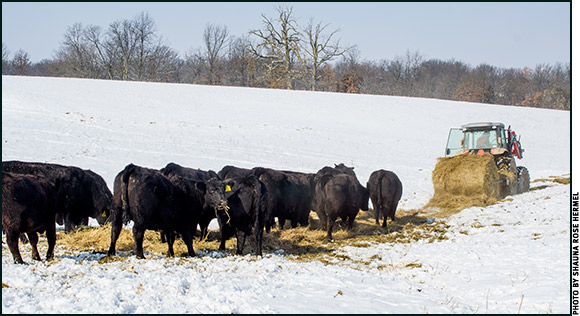HEALTH & NUTRITION...

Cold Stress Affects Cow Energy Needs
Consider coat condition, wind chill when assessing effects of the cold.
Most beef producers understand that when the weather gets colder their cattle need more energy for maintenance. So at what temperature do cattle actually begin experiencing cold stress, and then how much more energy do they need?
The answer takes a couple of factors into consideration, explained Warren Rusche, South Dakota State University (SDSU) Extension beef feedlot management associate.
“The actual temperature and wind speed interact to determine the effective temperature,” Rusche said. Read more.
Size Matters when it Comes
to Forages Fed to Beef Cattle
Research tries to determine optimal forage particle size and amount in finishing diets.
Just how much forage does a ruminant need if a ruminant does need forage?
Jenny Jennings, a Texas A&M AgriLife Research beef nutritionist in Amarillo, and her team are on their second research trial aimed at determining forage needs for proper rumination in beef cattle consuming high-concentrate diets.
“We want to feed finishing cattle in an efficient manner that best utilizes our commodity resources while maintaining animal health and well-being,” Jennings said.
“Roughage has always been known to be an important part of a ruminant’s diet, but has been largely forgotten about in feedlot research,” she said. “Limited forage in a grain-based diet can result in metabolic disorders on the back end, which can cost the producer and the packer money.” Read more.
Treatment Protocols for Sick Cattle
K-State’s Mike Apley discusses establishment of protocols to help cattlemen in treating sick cattle.
Improving animal welfare is a goal within the beef industry. This goal requires training to ensure all parties follow specific guidelines and standards.
“We can’t rely on people following instructions without them being written down,” said Mike Apley, Kansas State University (K-State) professor of production medicine. Veterinarians rely more and more on written instructions for prevention and treatment procedures. As such, it’s important that operations develop protocols for treating sick cattle. Read more.
Call Your Veterinarian Before It’s a Crisis
Use your veterinarian as a herd health consultant rather than disaster cleanup.
It is always beneficial to have a good working relationship with your veterinarian. Veterinarians can assist in herd health management strategies and preventative medicine, rather than just helping in emergencies. Yet, producers tend to have a narrow perspective of what veterinarians can offer, especially if the veterinarian is only called upon to treat problems.
If a serious health problem develops in a herd, something has already gone wrong. It’s not always easy, however, to convince ranchers they should use their veterinarian as a consultant for herd health rather than just calling when there’s a crisis. Read more.
Factors that Affect Ability of Cattle
to Handle Cold Weather
Cold weather influences cattle feed intake requirements.
When days are short and weather is cold, cattle have ways to create more body heat and to conserve body heat: metabolism increases, feed intake increases and passage of feed through the digestive tract speeds up. Feed requirements for cattle may go up as much as 10%-25%, says Julie Walker, Extension beef specialist for South Dakota State University. All of these changes contribute to an increase in heat production, so the animal can withstand winter temperatures.
Cattle can tolerate colder temperatures if they have a good winter hair coat.
“As long as their heavy winter coat is dry, they are [more] comfortable at lower temperatures than if the hair is wet. Also, they do best if they have a chance to grow a good hair coat before extremely cold weather. If we go through a normal progression into winter and a gradual change, they can deal with it much better than when we had the blizzard of October 2013 here in South Dakota. Those cows were still in a transitional stage with a fall hair coat; they didn’t have their thick winter coats on,” says Walker. Read more.
Importance of Winter Water
Provide an open water source to cattle, even if there is snow on the ground.
Cattle have to consume more feed during cold weather to generate additional body heat. A great deal of body heat can be produced by the breakdown of forages in the rumen, due to the heat of fermentation and digestion. In order to process the additional feed, however, the digestive tract needs adequate fluid. A cow’s water requirement may not be as high in the winter as it is in the summer, but she needs to drink enough water during cold weather to handle the demands of ruminant digestion and increased metabolism, to prevent dehydration and impaction. Thus, it is important to provide adequate water for livestock during cold weather. Read more.
Cattle Diseases: Common Conditions/Terms
Click here for a list of common conditions and terms related to beef cattle diseases, such as anaplasmosis, brucellosis, BVD, E. coli, IBR and others.
[Click here to go to the top of the page.]






